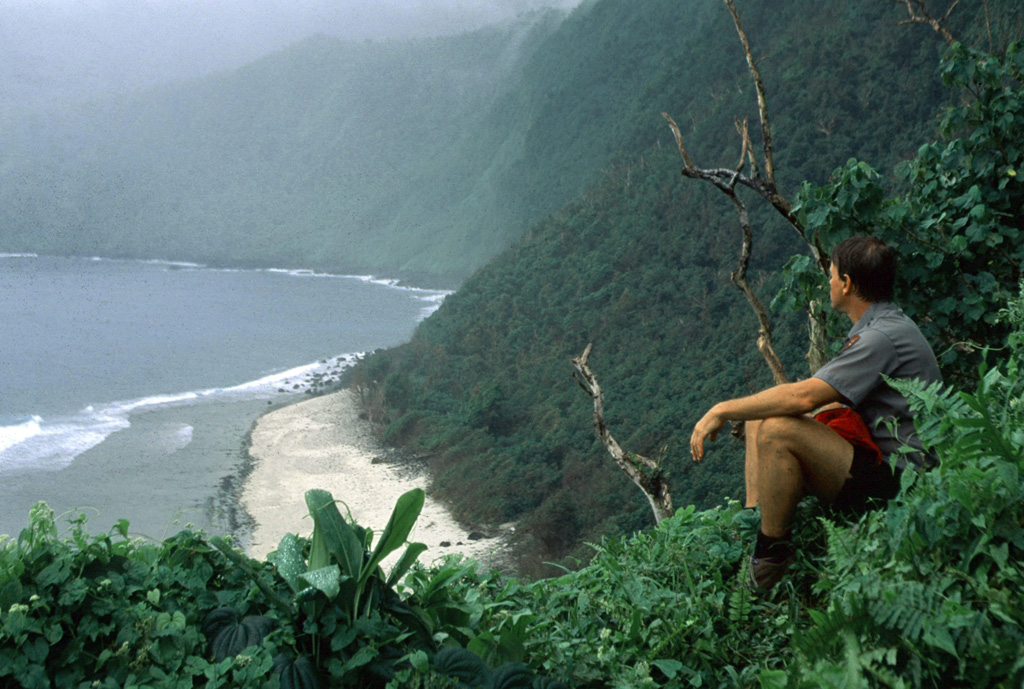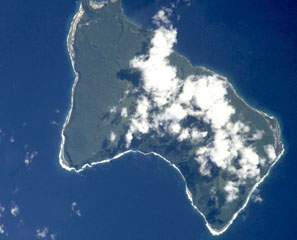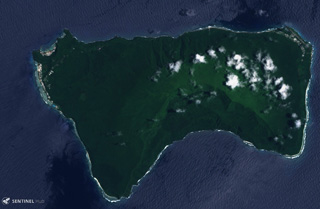

HVO lowered the Volcano Alert Level for Ta’u to Normal (the lowest level on a four-level scale) and the Aviation Color Code to Green (the lowest level on a four-color scale) on 3 October, noting that seismic activity had dramatically decreased and maintained low levels over the past few weeks. Analysis of data from one seismometer that had recorded earthquakes during 2005-2009 suggested that a rate of five detected earthquakes per day was characteristic of long-term background seismicity; the current earthquakes rates were at background levels.
Source: US Geological Survey Hawaiian Volcano Observatory (HVO)
HVO lowered the Volcano Alert Level for Ta’u to Normal (the lowest level on a four-level scale) and the Aviation Color Code to Green (the lowest level on a four-color scale) on 3 October, noting that seismic activity had dramatically decreased and maintained low levels over the past few weeks. Analysis of data from one seismometer that had recorded earthquakes during 2005-2009 suggested that a rate of five detected earthquakes per day was characteristic of long-term background seismicity; the current earthquakes rates were at background levels.
Source: US Geological Survey Hawaiian Volcano Observatory (HVO)
HVO reported that an earthquake swarm around Ta’u, in the Manu'a Islands of American Samoa, continued during 30 August-6 September. Less than 30 earthquakes per day were large enough to be felt by residents and many more earthquakes undetectable by humans were also recorded; no earthquakes were reportedly felt during 5-6 September. The data suggested that the earthquakes were consistently occurring in an area about 5-15 km off the N shore of the island, at depths of 10-15 km below the surface. There was no change in the frequency or size of earthquakes and the position of the swarm remained unchanged. USGS staff installed GPS equipment during 4-6 September. The Volcano Alert Level remained at Advisory and the Aviation Color Code remained at Yellow.
Source: US Geological Survey Hawaiian Volcano Observatory (HVO)
HVO reported that an earthquake swarm in the Manu'a Islands of American Samoa continued to be felt by residents of Ta'u Island and Ofu-Olosega islands during 24-30 August. Three advanced seismometers were installed beginning the second week of August, one on Ofu Island and two on Ta'u, and by 26 August the data indicated that the source of the activity was related to Ta'u Island. Around 30 earthquakes per hour were recorded each day. At 2033 on 23 August an earthquake widely felt by residents of the Manu'a islands and Tutuila Island was characterized as producing light-to-moderate shaking (a maximum Intensity of V on the Modified Mercalli Intensity Scale); the estimated M 3-3.5 event was the largest recorded since the new instruments were installed. The largest earthquakes recorded during 25-26 August had estimated magnitudes between 3 and 4 and were felt by residents of Manu'a. An estimated M 2.8 event was strongly felt at 0932 on 27 August. Numerous events were felt during 27-28 August, but none were reported during 28-30 August. Booming noises had been reported and investigated for weeks; scientists confirmed that they were related to the earthquakes, noting that the sound waves generated by some earthquakes could produce sounds audible to humans. No signs of ground cracking, landslides, rockfalls, or other activity that could have caused the sounds were seen. The Volcano Alert Level remained at Advisory and the Aviation Color Code remained at Yellow.
Source: US Geological Survey Hawaiian Volcano Observatory (HVO)
HVO reported that an earthquake swarm in the Manu’a Islands of American Samoa continued to be recorded and felt by residents of Ta’u Island and Ofu-Olosega. About 20 earthquakes per hour were recorded by four microseismometers distributed on Tutuila, Ta’u, and Ofu-Olosega Islands. The largest events were estimated to be between magnitudes 2 and 3; most events are too small to be felt. Analysis of the seismic data indicated that the earthquakes were occurring beneath or around the Manu’a Islands, likely closer to Ta’u rather than Ofu-Olosega, though the exact locations, depths, and magnitudes were unknown. The number, size, and frequency of earthquakes recorded by instruments and being felt by people and on both islands indicated that seismicity was above background levels; HVO changed the Volcano Alert Level to Advisory and the Aviation Color Code to Yellow for both volcanoes. Earthquakes continued to be recorded at around the same rate during 20-22 August. Two additional seismometers were installed on Ta’u during 22-23 August.
Source: US Geological Survey Hawaiian Volcano Observatory (HVO)
HVO reported that earthquakes were felt by residents of the Manu'a group of islands in American Samoa beginning on 26 July. Residents of Ofu and Olosega islands began reporting earthquakes on 10 August. Experts from HVO, Pago Pago National Weather Service Office (NWS), National Oceanic and Atmospheric Administration (NOAA) Pacific Tsunami Warning Center, NOAA-IOC (NOAA-Intergovernmental Oceanographic Commission), International Tsunami Information Center, and USGS National Earthquake Information Center have been working together to respond to the unrest. USGS scientists arrived on the islands and installed two microseismometers, one in Fiti'uta village on Ta'u island on 13 August and the other in Olosega village on 14 August. The instruments began recording about 20 earthquakes per hour. The largest earthquakes, including the felt events, were estimated to be between magnitudes 2 and 3; most of the events were too small to be felt. The exact location and depth of these earthquakes was unknown, due to limited earthquake monitoring equipment, though the data suggested that the events were beneath the Manu'a Islands, likely closer to Ta'u island rather than Ofu-Olosega, and were probably not related to the recently active Vailulu'u seamount. HVO noted that American Samoa’s volcanoes were monitored remotely by satellites and a distant seismic station in Apia, Samoa; the lack of ground-based monitoring stations does not allow for advanced warning of new activity. Both the Volcano Alert Level and Aviation Color Code were categorized as Unassigned due to the lack of a volcano-monitoring network.
Source: US Geological Survey Hawaiian Volcano Observatory (HVO)
The Global Volcanism Program has no Bulletin Reports available for Ta'u.
|
|
||||||||||||||||||||||||||
The Global Volcanism Program is not aware of any Holocene eruptions from Ta'u. If this volcano has had large eruptions (VEI >= 4) prior to 12,000 years ago, information might be found on the Ta'u page in the LaMEVE (Large Magnitude Explosive Volcanic Eruptions) database, a part of the Volcano Global Risk Identification and Analysis Project (VOGRIPA).
This compilation of synonyms and subsidiary features may not be comprehensive. Features are organized into four major categories: Cones, Craters, Domes, and Thermal Features. Synonyms of features appear indented below the primary name. In some cases additional feature type, elevation, or location details are provided.
Cones |
||||
| Feature Name | Feature Type | Elevation | Latitude | Longitude |
| Fa'asemene | Tuff cone | 14° 13' 1.00" S | 169° 30' 29.00" W | |
| Faleasao | Tuff cone | 14° 13' 0.00" S | 169° 30' 43.00" W | |
| Lepu'e | Cone | 14° 13' 19.00" S | 169° 29' 10.00" W | |
| Luatele | Shield volcano | 14° 13' 37.00" S | 169° 25' 59.00" W | |
| Maluatia | Cone | |||
| Olomanu | Cone | 14° 14' 0.00" S | 169° 29' 6.00" W | |
| Olomatimu | Cone | 14° 13' 55.00" S | 169° 28' 26.00" W | |
| Olotania | Cone | 14° 14' 13.00" S | 169° 28' 0.00" W | |
| Sa'umane | Cone | 14° 13' 16.00" S | 169° 26' 0.00" W | |
| To'a | Tuff cone | 14° 12' 47.00" S | 169° 30' 18.00" W | |
| Tunoa | Shield volcano | 14° 14' 0.00" S | 169° 30' 0.00" W | |
Craters |
||||
| Feature Name | Feature Type | Elevation | Latitude | Longitude |
| Lata | Pleistocene caldera | 14° 15' 0.00" S | 169° 27' 7.00" W | |
| Lualaititi | Pit crater | 14° 13' 30.00" S | 169° 26' 0.00" W | |
 Steep sea cliffs surround the 6 x 10 km Ta'u Island, located at the eastern end of the Samoan islands. The island is the exposed portion of the large Lata shield volcano. Collapse and landslide erosion of the southern portion of the shield volcano have left an arcuate, south-facing embayment (bottom) with a steep headwall. A tuff-cone complex is partially visible at the extreme NW tip of the island (top). The historic village of Fitiiuta lies at the NE tip of the island (far right).
Steep sea cliffs surround the 6 x 10 km Ta'u Island, located at the eastern end of the Samoan islands. The island is the exposed portion of the large Lata shield volcano. Collapse and landslide erosion of the southern portion of the shield volcano have left an arcuate, south-facing embayment (bottom) with a steep headwall. A tuff-cone complex is partially visible at the extreme NW tip of the island (top). The historic village of Fitiiuta lies at the NE tip of the island (far right). Sheer, forested cliffs form the southern side of Ta'u Island at the eastern end of the Samoan Islands. Partial collapse of the shield volcano formed a large arcuate depression open to the S. The 6 x 10 km Island is the emergent portion of the large Lata shield volcano, which also contains numerous Holocene post-caldera cones at the summit and flanks.
Sheer, forested cliffs form the southern side of Ta'u Island at the eastern end of the Samoan Islands. Partial collapse of the shield volcano formed a large arcuate depression open to the S. The 6 x 10 km Island is the emergent portion of the large Lata shield volcano, which also contains numerous Holocene post-caldera cones at the summit and flanks. Ta’u Island in eastern American Samoa is the exposed portion of the Lata shield volcano, seen in this 29 October 2019 Sentinel-2 satellite image (N is at the top; this image is approximately 13 km across). Smaller cones and craters have formed across the flanks, and a major flank collapse event around 22 ka resulted in the steep scarps on the southern side of the island.
Ta’u Island in eastern American Samoa is the exposed portion of the Lata shield volcano, seen in this 29 October 2019 Sentinel-2 satellite image (N is at the top; this image is approximately 13 km across). Smaller cones and craters have formed across the flanks, and a major flank collapse event around 22 ka resulted in the steep scarps on the southern side of the island.There are no samples for Ta'u in the Smithsonian's NMNH Department of Mineral Sciences Rock and Ore collection.
| Copernicus Browser | The Copernicus Browser replaced the Sentinel Hub Playground browser in 2023, to provide access to Earth observation archives from the Copernicus Data Space Ecosystem, the main distribution platform for data from the EU Copernicus missions. |
| MIROVA | Middle InfraRed Observation of Volcanic Activity (MIROVA) is a near real time volcanic hot-spot detection system based on the analysis of MODIS (Moderate Resolution Imaging Spectroradiometer) data. In particular, MIROVA uses the Middle InfraRed Radiation (MIR), measured over target volcanoes, in order to detect, locate and measure the heat radiation sourced from volcanic activity. |
| MODVOLC Thermal Alerts | Using infrared satellite Moderate Resolution Imaging Spectroradiometer (MODIS) data, scientists at the Hawai'i Institute of Geophysics and Planetology, University of Hawai'i, developed an automated system called MODVOLC to map thermal hot-spots in near real time. For each MODIS image, the algorithm automatically scans each 1 km pixel within it to check for high-temperature hot-spots. When one is found the date, time, location, and intensity are recorded. MODIS looks at every square km of the Earth every 48 hours, once during the day and once during the night, and the presence of two MODIS sensors in space allows at least four hot-spot observations every two days. Each day updated global maps are compiled to display the locations of all hot spots detected in the previous 24 hours. There is a drop-down list with volcano names which allow users to 'zoom-in' and examine the distribution of hot-spots at a variety of spatial scales. |
|
WOVOdat
Single Volcano View Temporal Evolution of Unrest Side by Side Volcanoes |
WOVOdat is a database of volcanic unrest; instrumentally and visually recorded changes in seismicity, ground deformation, gas emission, and other parameters from their normal baselines. It is sponsored by the World Organization of Volcano Observatories (WOVO) and presently hosted at the Earth Observatory of Singapore.
GVMID Data on Volcano Monitoring Infrastructure The Global Volcano Monitoring Infrastructure Database GVMID, is aimed at documenting and improving capabilities of volcano monitoring from the ground and space. GVMID should provide a snapshot and baseline view of the techniques and instrumentation that are in place at various volcanoes, which can be use by volcano observatories as reference to setup new monitoring system or improving networks at a specific volcano. These data will allow identification of what monitoring gaps exist, which can be then targeted by remote sensing infrastructure and future instrument deployments. |
| Volcanic Hazard Maps | The IAVCEI Commission on Volcanic Hazards and Risk has a Volcanic Hazard Maps database designed to serve as a resource for hazard mappers (or other interested parties) to explore how common issues in hazard map development have been addressed at different volcanoes, in different countries, for different hazards, and for different intended audiences. In addition to the comprehensive, searchable Volcanic Hazard Maps Database, this website contains information about diversity of volcanic hazard maps, illustrated using examples from the database. This site is for educational purposes related to volcanic hazard maps. Hazard maps found on this website should not be used for emergency purposes. For the most recent, official hazard map for a particular volcano, please seek out the proper institutional authorities on the matter. |
| IRIS seismic stations/networks | Incorporated Research Institutions for Seismology (IRIS) Data Services map showing the location of seismic stations from all available networks (permanent or temporary) within a radius of 0.18° (about 20 km at mid-latitudes) from the given location of Ta'u. Users can customize a variety of filters and options in the left panel. Note that if there are no stations are known the map will default to show the entire world with a "No data matched request" error notice. |
| UNAVCO GPS/GNSS stations | Geodetic Data Services map from UNAVCO showing the location of GPS/GNSS stations from all available networks (permanent or temporary) within a radius of 20 km from the given location of Ta'u. Users can customize the data search based on station or network names, location, and time window. Requires Adobe Flash Player. |
| DECADE Data | The DECADE portal, still in the developmental stage, serves as an example of the proposed interoperability between The Smithsonian Institution's Global Volcanism Program, the Mapping Gas Emissions (MaGa) Database, and the EarthChem Geochemical Portal. The Deep Earth Carbon Degassing (DECADE) initiative seeks to use new and established technologies to determine accurate global fluxes of volcanic CO2 to the atmosphere, but installing CO2 monitoring networks on 20 of the world's 150 most actively degassing volcanoes. The group uses related laboratory-based studies (direct gas sampling and analysis, melt inclusions) to provide new data for direct degassing of deep earth carbon to the atmosphere. |
| Large Eruptions of Ta'u | Information about large Quaternary eruptions (VEI >= 4) is cataloged in the Large Magnitude Explosive Volcanic Eruptions (LaMEVE) database of the Volcano Global Risk Identification and Analysis Project (VOGRIPA). |
| EarthChem | EarthChem develops and maintains databases, software, and services that support the preservation, discovery, access and analysis of geochemical data, and facilitate their integration with the broad array of other available earth science parameters. EarthChem is operated by a joint team of disciplinary scientists, data scientists, data managers and information technology developers who are part of the NSF-funded data facility Integrated Earth Data Applications (IEDA). IEDA is a collaborative effort of EarthChem and the Marine Geoscience Data System (MGDS). |